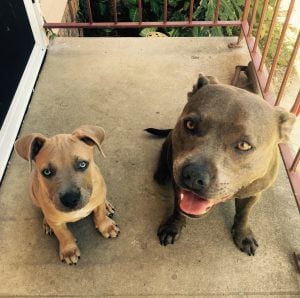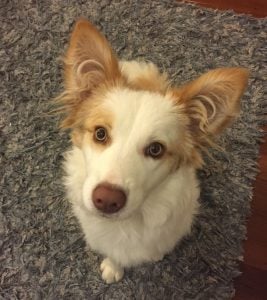Little pups are so sweet and cuddly with their unmistakable ‘puppy-breath’, some would describe them as being very more-ish. Many are bold and outgoing, some are full of energy and have a regular ‘crazy puppy zoom sessions’, and a few are quieter and less boisterous. But what about those little guys that seem nervous about new places, new people or new toys? And what about those that are genuinely scared?
Feeling scared, when appropriate, is a natural emotion aimed at motivating an animal to survive. That is to say that if your dog were lying on the drive way, the loud noise of the car would startle it and scare it into action to move out of the way – a most useful preservation skill in such scenario. However, a new puppy that is avoiding all contact with a loving family because it’s hiding behind the couch is not conducive to survival longer than a couple of days… As with small children, there is a lot that goes in to how a puppy expresses its behaviour in a particular situation: whether they’re hungry, tired, sick or over-excited. In general terms the long-term influences usually fall into one of three categories: inherited predispositions, current environment and learning from previous experiences.
Inherited Predisposition:
A pup’s genetic make-up certainly plays a role in how it behaves. For example, if its mum or dad was a very anxious dog, your pup may be predisposed to being a little more anxious or cautious than other pups of the same breed. The environment that its mum was kept in while she was pregnant also plays a role. If she was kept in a very stressful environment, her stress hormones would influence the developing puppies’ brains so that they are ‘wired’ to always be on the look out for danger and threats and be more predisposed to being anxious dogs.
Current Environment:
If a pup is not able to freely access the 5 basic needs: water, food, clean air, shelter and feeling safe, it will immediately

Nervous little dog – pulling away, pupils dilated, ears very alert, tense body
cause stress. This means that if a pup doesn’t have clean water, or not enough to eat, or is kept in an enclosure where it’s not cleaned frequently and has poor air quality, or is getting too hot or too cold, it will automatically seek to satisfy those needs and show distress if it’s not able. Feeling safe is easy to tell from a pup’s body language, if you know what to look for! A scared pup will show one or more of the following signs: dropped ears, low or tucked tail, pulling back or crouching body posture, running away, hiding, trying to escape, shivering, shaking, salivating, crying or whimpering and eventually may resort to aggressive behaviours if the threat does not dissipate. (See pic opposite of a nervous little dog)
A pup that feels safe will have a relaxed body posture, a tail held at mid-height, relaxed facial expression, ears listening but not scanning frantically (see pics below). A pup in this state is curious and will often seek to interact with other dogs and people and investigate new toys, food and other objects.
So how do you know if there is a problem with the pup’s current environment? The simple answer is: Watch your pup! If he is showing any of the ‘scared’ signs mentioned above, you need to take note and take action. For example: on your pup’s first outing for a walk down the road, you see a big dog coming towards you that is barking at every other person and dog in the street. You notice that your pup has seen this big dog and is starting to tuck its tail, shrink down and hide behind your legs. At best, pushing through with walking passed this big scary dog is not going to teach your pup anything useful! At worst, your pup will learn that “Big dogs are scary nutcases!” and / or “My owner can’t be trusted to take evasive action, I’m going to have to try escaping / barking back / climbing up her legs next time” or any number of other strategies it hopes may work. So, the long and the short of it is to not force a pet that is already showing behavioural signs of anxiety, to continue to endure the situation.
Learning From Previous Experiences:
As already discussed above, animals are pretty smart at learning from a previous experience. Furthermore, pups that have a scary experience, particularly if it is during a sensitive period (~6-14 weeks old and around 6 months old), can leave a lasting impression on their ‘world view’ i.e. the world is always a very scary place. As an example in people, ask any person whether they’d voluntarily go through being caught in a war zone with no foreseeable rescue, and the answer would be a resoundingly no. Similarly for a young dog exposed to a fireworks display, experiencing loud explosions, flashes of light and no viable route of escape, subsequent exposures would most likely lead to phobia and panic behaviours. Going through the same experience, feeling the same scary emotions merely serves to reinforce a pet’s idea that something is frightening and needs to be avoided at all costs.
The Good News:

The good news is that if you have a timid pup you can do a lot to help him feel more comfortable and learn that not everything in the world is scary. Being aware of your pup’s body language and what he’s trying to communicate to you is key. If you are aware, you are able to take evasive action or modify the situation so that your pup is able to feel safe again as quickly aspossible. It means socialising your pup with calm, friendly people and other pets while your puppy is showing calm, relaxed behaviours. This may mean that you need to tell the over enthusiastic neighbour that her boisterous toddler can’t pick up your pup, but that she can drop some liver treats on the floor for the puppy to eat if it feels comfortable enough to do so. It means that by using food rewards and positive reinforcement you can gradually train your pup to be calm and relaxed in most situations.
By the same token, if you are noticing that your puppy seems to be excessively nervous in any one or multiple situations, it is definitely worth looking in to. Very rarely will an issue like this improve with time and most likely will progress to a fear or phobia. Early intervention is far more effective at resolving a fear-based behaviour. If you are concerned about your pup or would like more information, please contact us by calling 0481 527 678 or email. We will be happy to help.


